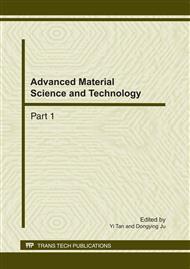p.201
p.205
p.209
p.215
p.219
p.223
p.227
p.231
p.235
4A-Molecular Sieve Synthesis by Microwave Heating with Silicon and Aluminum Materials Produced from the Coal Fly Ash
Abstract:
A new method, using sodium silicate and sodium aluminate synthesize 4A-molecular sieve, was developed by using microwave technology. The sodium silicate was a high modulus liquor by-product of nano-silica production from coal fly ash. Meanwhile, the sodium aluminate was a process by-product of alumina extraction from coal fly ash. Reaction mixture composition was defined as follow:SiO2/Al2O3 ratio in 2.0, Na2O/SiO2 ratio in 1.5, and H2O/Na2O ratio in 65. The gelation process was completed in 1 hr. Microwave crystallization power was (800w) 30%. Microwave crystallization period can last 25 mins. The 4A-molecular sieve was obtained by collecting crystals from the reaction mixture through filtration after washing with water to pH 11-12 and drying inside isotherm oven. The calcium exchange capacity and effective pore size of the product were 316mg/g and 0.4nm respectively. Over 90% of surface pore size reached in sizes of less than or equal to 8μm. Purity of 4A-molecular sieve up to 99%. This method significantly reduced the raw material costs for sodium silicate and sodium aluminate. In addition, the adoption of microwave technology also lowered the energy usage and shortened crystallization time. All these contributed final low costs of 4A-molecular sieve product, which made it possible for many practical applications.
Info:
Periodical:
Pages:
219-222
Citation:
Online since:
February 2011
Authors:
Keywords:
Price:
Сopyright:
© 2011 Trans Tech Publications Ltd. All Rights Reserved
Share:
Citation:


